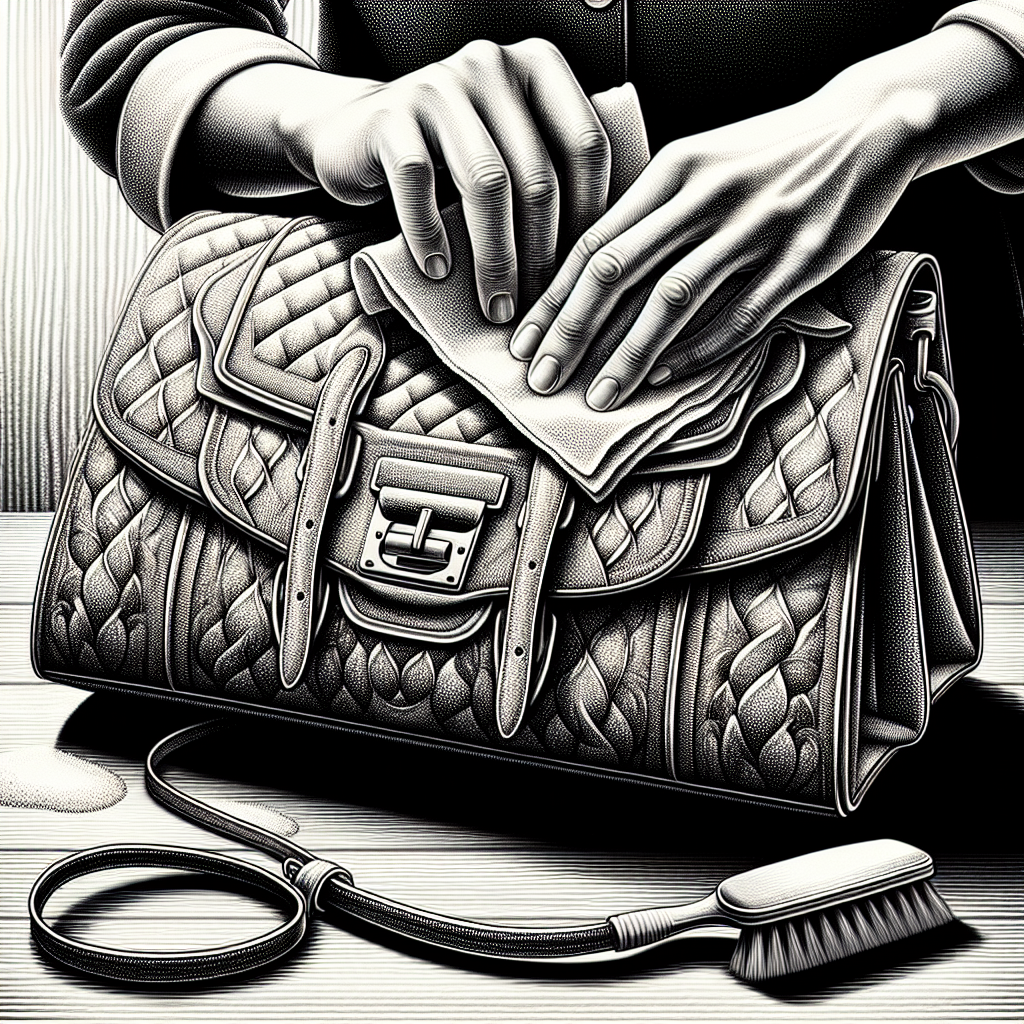Do Dry Cleaners Clean Purses
If you’ve ever wondered whether your favorite dry cleaner can handle the task of cleaning your handbag, you’re not alone. Purses, especially those made of delicate materials or adorned with intricate details, require special care and attention when it comes to cleaning. In this article, we’ll explore the world of dry cleaning and answer the burning question: do dry cleaners clean purses? Whether you’re concerned about removing stubborn stains or preserving the longevity of your beloved bag, we’ve got you covered. So, let’s uncover the secrets of proper purse cleaning and discover if your local dry cleaner is up to the task!
Introduction
What is dry cleaning?
Dry cleaning is a professional cleaning method that uses chemicals and specialized machines instead of water to clean fabrics and garments. It is called “dry” cleaning because it does not involve the use of any water during the cleaning process. Instead, it relies on solvents to remove dirt, stains, and odors from clothing items and other textiles.
Why do people use dry cleaners?
There are several reasons why people choose to use dry cleaners for their laundry needs. One of the main reasons is the convenience factor. Dry cleaning services save you time and effort by taking care of the entire cleaning process, including laundering, ironing, and folding. This can be particularly helpful for individuals who lead busy lifestyles or do not have access to laundry facilities.
Another reason why people opt for dry cleaning is to maintain the condition and longevity of their clothing. Some garments, such as suits, delicate fabrics, and formal wear, may require special care and attention that cannot be provided by traditional washing methods. Dry cleaners have the knowledge and expertise to handle these items properly and ensure they are returned in excellent condition.
Common items taken to dry cleaners
While dry cleaners are primarily known for cleaning clothing, they also handle a wide range of other items. Some common items taken to dry cleaners include:
-
Suits and formal wear: Dry cleaning is often the preferred method for cleaning suits, tuxedos, and other formal attire. The process helps maintain the shape and structure of these garments while removing stains and odors.
-
Dresses and gowns: Many dresses and gowns, especially those made from delicate fabrics like silk or satin, are best cleaned using dry cleaning methods. This ensures that the intricate details and embellishments of the garment remain intact.
-
Coats and jackets: Outerwear items, such as wool coats or leather jackets, can be challenging to clean at home. Dry cleaners have the expertise to clean and restore these items without causing any damage.
-
Beddings and linens: Dry cleaning can also be used for large items like comforters, duvets, and curtains. This method helps to remove dust, allergens, and stains effectively, leaving these household items fresh and clean.
-
Specialty items: Dry cleaners may also handle specialty items like wedding dresses, vintage clothing, and costumes. These unique pieces often require extra care and attention to preserve their quality and value.
Understanding Dry Cleaning
Explanation of the dry cleaning process
Dry cleaning involves several steps to ensure the effective cleaning of garments. The process begins with the inspection of the item for any stains, tears, or other damages. The dry cleaner will then treat these spots individually before placing the garment in a machine.
Once inside the machine, the clothing item is cleaned using a solvent, typically perchloroethylene (perc) or a safer alternative like hydrocarbon or liquid CO2. The solvent helps dissolve and lift away dirt, oils, and stains from the fabric without causing any damage.
After the cleaning cycle is complete, the garment goes through a drying phase to remove any remaining solvent. Finally, the item is inspected once again to ensure its cleanliness and pressed if necessary before being packaged for pick-up or delivery.
Benefits of dry cleaning over traditional washing methods
Dry cleaning offers several benefits over traditional washing methods, making it the preferred choice for many individuals.
Firstly, the dry cleaning process is gentler on fabrics compared to water-based washing. Traditional washing methods can cause shrinkage, color bleeding, and fabric distortion in delicate or structured garments. Dry cleaning, on the other hand, uses specialized solvents that are less abrasive and reduce the risk of damage.
Secondly, dry cleaning is effective in removing tough stains and odors that may be difficult to eliminate with regular washing. The solvents used in the process are highly efficient in breaking down oils, grease, and other residue, resulting in cleaner and fresher garments.
Lastly, dry cleaning can help prolong the lifespan of your clothing. By removing dirt and stains and preventing the buildup of residue, dry cleaning can help preserve the colors, textures, and overall quality of your garments. This extends their wearability and ensures they look their best for longer.
Suitability of materials for dry cleaning
While dry cleaning is suitable for a wide range of materials, it is important to note that not all fabrics can be safely cleaned using this method. It is always recommended to check the care label on your clothing items to determine their recommended cleaning method.
Generally, fabrics like silk, wool, cashmere, and delicate synthetics are well-suited for dry cleaning. These materials often require extra care and attention to maintain their appearance and integrity. On the other hand, sturdy materials like cotton, linen, and polyester can usually be cleaned using traditional washing methods.
It is also important to consider the construction of the garment when deciding whether to dry clean it. Structured items like suits, jackets, and tailored pieces often benefit from dry cleaning because it helps maintain their shape and structure. Meanwhile, unstructured or loose-knit items might be better suited for other cleaning methods.
Understanding different types of purses
Purses come in various shapes, sizes, and styles, each serving a different purpose and catering to different needs. Understanding the different types of purses can help you determine the appropriate cleaning methods and care for your specific bag.
-
Tote bags: Tote bags are large, open-top bags with sturdy handles, usually made from durable materials like canvas or leather. They are versatile and suitable for carrying a range of items, from groceries to work essentials.
-
Shoulder bags: Shoulder bags have a single or double strap, allowing them to be worn on the shoulder or carried by hand. They come in various sizes and are popular as everyday bags or for special occasions.
-
Crossbody bags: Crossbody bags have a long, adjustable strap that allows them to be worn diagonally across the body. They provide a hands-free option and are commonly used for casual outings or travel.
-
Clutch bags: Clutch bags are small, handheld purses without any straps. They are typically used for formal occasions or evenings out when carrying minimal items.
-
Satchel bags: Satchel bags are structured, large bags with a top handle and a long, detachable shoulder strap. They offer both functionality and style, making them popular for work or travel.
-
Backpacks: While traditionally associated with school or outdoor activities, backpacks have become a trendy accessory for everyday use. They provide ample storage and are comfortable to wear on the back.
Materials and construction of purses
Purses are crafted from a variety of materials, each requiring different cleaning methods and care.
-
Leather: Leather purses are stylish and durable, often considered a long-lasting investment. Genuine leather requires special care and should be cleaned by professionals to prevent damage or discoloration.
-
Fabric: Purses made from fabric materials, such as canvas or cotton, are generally easier to clean. They can often be safely hand-washed or spot cleaned at home, depending on the specific fabric.
-
Synthetic materials: Purses made from synthetic materials like nylon or polyester are typically more resistant to stains and can be cleaned using mild detergent and water. However, it is always best to check the care label for specific instructions.
-
Exotic materials: Purses made from exotic materials like snakeskin, suede, or fur require extra care and specialized cleaning methods. It is advisable to consult professionals or the purse manufacturer for cleaning recommendations.
Factors to consider before taking a purse to a dry cleaner
Before taking your purse to a dry cleaner, there are a few factors you should consider to ensure the best possible outcome:
-
Material compatibility: Check the care label or consult the manufacturer to determine whether your purse is compatible with dry cleaning. Some materials, especially delicate fabrics or exotic materials, may require alternative cleaning methods.
-
Construction and embellishments: Take note of any intricate details, embellishments, or hardware on your purse. Some components, such as beads, jewels, or chains, may be sensitive to dry cleaning solvents and could be damaged in the process.
-
Stains and odor: Assess the extent of any stains or odor on your purse. Dry cleaning is highly effective at removing stains, but it is always a good idea to inform the dry cleaner about any specific stains or odors so that they can treat them accordingly.
-
Age and condition: Consider the age and overall condition of your purse. Older or more delicate purses may require extra care and attention during the cleaning process to prevent any further damage.
Cleaning Methods for Purses
Spot cleaning techniques for small stains
Spot cleaning can be an effective way to address small stains on your purse. Here are a few techniques you can try:
-
Blotting: For liquid-based stains, such as spills or ink, blot the affected area gently with a clean, absorbent cloth or paper towel. Avoid rubbing, as it may spread the stain further. Repeat as necessary until the stain is no longer visible.
-
Mild detergent and water: Mix a small amount of mild detergent with water to create a gentle cleaning solution. Dampen a clean, soft cloth with the solution and gently dab the stained area, being careful not to saturate the fabric. Blot with a clean cloth to remove any excess moisture.
-
Stain-specific solutions: Some stains, like oil or grease, may require specialized stain removers. Test the product on an inconspicuous area of your purse before applying it to the stain. Follow the manufacturer’s instructions and rinse the area thoroughly afterward.
Home remedies for purse cleaning
If you prefer to clean your purse at home, there are a few home remedies you can try using common household items:
-
Baby wipes: Baby wipes are gentle and can be used to wipe down the exterior of your purse. They are particularly useful for removing surface dirt and smudges.
-
White vinegar: For mild odors, mix equal parts white vinegar and water in a spray bottle. Spray the solution lightly on the interior of your purse and let it air dry. The vinegar helps neutralize odors without leaving behind a strong scent.
-
Baking soda: Baking soda is a natural deodorizer. Sprinkle a small amount inside your purse, leave it overnight, and then vacuum it out the next morning. This can help absorb any lingering odors.
-
Cornstarch or talcum powder: These powders can be used to absorb grease or oil stains on fabric or leather purses. Sprinkle the powder directly on the stain, let it sit for a few hours, and then brush or wipe it away.
While these home remedies can be effective for light cleaning and maintenance, it is important to remember that more stubborn stains or delicate materials may require professional cleaning.
Professional cleaning services for purses
For effective and safe cleaning of your purse, professional dry cleaning services are highly recommended. Dry cleaners have the experience, equipment, and knowledge to handle a wide range of purse materials and stains.
When taking your purse to a professional cleaner, it is crucial to inform them about any specific stains, odors, or concerns you may have. This will help them determine the appropriate cleaning methods and ensure the best possible results.
Professional cleaning methods may involve specialized solvents, steaming, spot cleaning, and overall rejuvenation of your purse. They can address both exterior and interior cleaning needs, leaving your purse looking fresh and revitalized.
Dry Cleaners and Purse Cleaning
Services offered by dry cleaners
Dry cleaners offer a range of services to meet various cleaning needs. When it comes to purses, here are some services you can expect:
-
Stain removal: Dry cleaners specialize in stain removal, utilizing their expertise and professional-grade cleaning solutions to tackle even the toughest stains on your purse.
-
Odor elimination: Dry cleaning can effectively remove unpleasant odors, whether they are caused by spills, everyday use, or prolonged storage.
-
Leather care: If you have a leather purse, dry cleaners can provide leather conditioning and treatment to keep the material supple, prevent cracking, and maintain its overall appearance.
-
Hardware maintenance: Dry cleaners can also help clean and polish any metal or hardware components on your purse, ensuring they remain in good condition.
-
Minor repairs: Some dry cleaners may offer minor repair services, such as fixing loose stitches, replacing buttons, or repairing small tears. This can help extend the lifespan of your purse.
Specific considerations for purses
When it comes to purse cleaning, dry cleaners understand the unique considerations and requirements. They are knowledgeable about different materials, construction techniques, and potential risks involved in cleaning purses.
Dry cleaners will take precautions to protect delicate fabrics, embellishments, and hardware during the cleaning process. They will also consider the specific stains or odors your purse may have and tailor their methods accordingly.
It is important to communicate any concerns or specific cleaning instructions to the dry cleaner to ensure they meet your expectations. Clear communication will help them determine the best approach to clean and restore your purse effectively.
Expertise and experience of dry cleaners
One of the advantages of using a professional dry cleaner is the expertise and experience they bring to the table. Dry cleaners have extensive knowledge about fabrics, materials, and the appropriate cleaning methods for different items.
Their experience allows them to handle delicate fabrics, intricate details, and high-end purses with care and precision. They are trained to identify potential risks and take necessary precautions to prevent any damage during the cleaning process.
By entrusting your purse to a reputable dry cleaner, you can have peace of mind knowing that it is in capable hands. Their expertise ensures that your purse will receive the attention it deserves, resulting in a thorough and effective cleaning.
Factors to Consider
Material compatibility with dry cleaning chemicals
Before taking your purse to the dry cleaner, it is crucial to determine whether the materials used in its construction are compatible with dry cleaning chemicals. Certain materials, such as silk, satin, or delicate fabrics, may be prone to damage or discoloration when exposed to strong solvents.
If you are uncertain about the suitability of your purse for dry cleaning, consult the care label or contact the manufacturer for guidance. They can provide specific instructions on how to clean and care for your particular purse material.
Potential risks and damage to purses
While dry cleaning is generally a safe and effective method for cleaning purses, there is always a possibility of risks or damage, particularly with delicate or older purses. The solvents used in dry cleaning can interact differently with various materials, causing discoloration, fading, or weakening of the fabric.
To minimize these risks, it is important to choose a reputable and experienced dry cleaner who understands the intricacies of purse cleaning. Researching and selecting a trusted dry cleaning establishment is crucial for ensuring the safety of your purse.
Recommendations from purse manufacturers
When in doubt about the appropriate cleaning method for your purse, refer to the manufacturer’s recommendations. Many purse manufacturers provide specific care instructions for their products, including cleaning methods and products to use or avoid.
Following these recommendations can help you maintain the lifespan and appearance of your purse. It is worth noting that deviating from the manufacturer’s recommendations may void any warranties or guarantees associated with your purse.
Finding a Reliable Dry Cleaner
Seeking recommendations from friends and family
When searching for a reliable dry cleaner to clean your purse, reaching out to friends, family, or colleagues for recommendations can be a helpful starting point. Personal referrals provide valuable insights into the quality of service and customer satisfaction offered by different dry cleaners in your area.
Ask about their experiences with purse cleaning specifically and inquire about any concerns or issues they may have encountered. This will help you assess the expertise and capabilities of each recommended dry cleaner and make an informed decision.
Researching local dry cleaning establishments
Take the time to research local dry cleaning establishments in your area. Visit their websites or contact them directly to learn more about their services, credentials, and any specialties they may have.
Look for dry cleaners that have experience cleaning purses or specialize in delicate items. It can also be beneficial to choose a dry cleaner that offers on-site inspections or consultations, allowing you to discuss your purse’s specific cleaning needs directly with their experts.
Checking for reviews and customer feedback
Online review platforms and customer feedback can provide valuable insights into the quality and reliability of different dry cleaners. Take the time to browse through reviews and testimonials from other customers who have used their services.
Pay attention to the feedback regarding purse cleaning, as this will give you an indication of how well the dry cleaner handles these specific items. Look for consistent positive reviews and check if any negative feedback relates to purse cleaning.
Preparing Your Purse for Cleaning
Emptying the contents of the purse
Before taking your purse to the dry cleaner, remove all items from inside, including loose change, receipts, makeup, and any personal belongings. Emptying the contents of your purse will ensure that nothing gets damaged or lost during the cleaning process.
Be thorough in your inspection, checking all compartments and pockets. Take note of any items that may require separate cleaning or treatment, such as cosmetic spills or ink stains.
Removing detachable parts and accessories
If your purse has any detachable parts or accessories, such as straps, charms, or decorative elements, consider removing them before taking your purse to the dry cleaner. Detachable parts can be cleaned separately or require alternative cleaning methods.
Consult the care label or the purse manufacturer’s instructions to determine the best way to clean these accessories. If in doubt, consult the dry cleaner for guidance on how to handle removable parts.
Securing delicate elements
If your purse has delicate or vulnerable elements, such as beading, embroidery, or sequins, take extra care to protect them during the cleaning process. Consider using a protective cover or bag to shield these elements from potential damage or snagging.
Inform the dry cleaner about any delicate elements or embellishments on your purse, so they can handle them with caution. They may take additional steps, such as using a protective mesh bag or manually spot cleaning these areas, to ensure their safety.
Communication with the Dry Cleaner
Providing accurate information about stains or damages
When discussing your purse with the dry cleaner, it is important to provide accurate and detailed information about any stains, damages, or concerns you may have. Be specific about the type of stain, when it occurred, and any previous attempts you made to remove it.
For damages or issues with your purse, describe the nature and location of the problem. This information will help the dry cleaner assess the best course of action and determine whether any additional repairs or treatments may be needed.
Expressing concerns and specific cleaning instructions
If you have any concerns or specific cleaning instructions for your purse, express them clearly to the dry cleaner. For example, if you are worried about color fading or have had a negative experience in the past, communicate this to the dry cleaner so they can take appropriate precautions.
Additionally, if there are specific parts or areas of your purse that require extra attention or caution, inform the dry cleaner. This could include delicate fabrics, intricate details, or hardware that may be more sensitive to the dry cleaning process.
Requesting a test spot or patch before full cleaning
If you have any doubts about how your purse will react to the dry cleaning process, it is perfectly acceptable to ask the dry cleaner for a test spot or patch before proceeding with the full cleaning. This allows you to assess the impact of the cleaning solvent on a small, inconspicuous area of your purse.
By requesting a test spot, you can gauge the potential risks and make an informed decision about whether to proceed with the full cleaning. This precautionary step can help avoid any unwanted surprises or damage to your purse.
Post-Cleaning Care
Inspecting the purse for any residual stains or damage
After you receive your cleaned purse from the dry cleaner, take the time to inspect it carefully for any residual stains or potential damage. Check both the exterior and interior of the purse, paying close attention to areas that may have been problematic before the cleaning.
If you notice any stains or damages that were not properly addressed, contact the dry cleaner promptly to discuss the issue and potential resolutions. It is important to address any concerns as soon as possible to ensure appropriate and timely actions can be taken.
Storing the cleaned purse properly
Proper storage is essential to maintain the cleanliness and condition of your purse after it has been cleaned. Consider the following tips for storing your purse:
-
Clean and dry: Ensure that your purse is completely dry before storing it. Leaving any moisture or dampness can lead to the growth of mold or mildew.
-
Stuffing: To help your purse maintain its shape, fill it with tissue paper or bubble wrap. This will prevent the bag from collapsing or losing its structure over time.
-
Dust bag: If your purse came with a dust bag or protective cover, use it to store your purse when not in use. This will protect it from dust, dirt, and potential damage.
-
Avoid direct sunlight: Store your purse in a cool, dry place away from direct sunlight, as prolonged exposure to sunlight can cause fading or discoloration.
Maintaining cleanliness and upkeep of the purse
To keep your purse clean and in good condition between cleaning sessions, consider the following maintenance tips:
-
Regular cleaning: Wipe down the exterior of your purse regularly with a soft cloth to remove surface dirt and dust. This simple step can help prevent the buildup of grime and maintain the appearance of your purse.
-
Avoid overloading: Be mindful of the weight and contents you carry in your purse. Overloading your purse can strain the seams and hardware, potentially causing damage or premature wear.
-
Protection from spills: Consider using a protective spray or fabric guard to help repel stains and spills on your purse. Be sure to test the product on a small, inconspicuous area before applying it to the entire purse.
-
Handle with care: When handling your purse, be mindful of any sharp objects or rough surfaces that may cause scratches or tears. Avoid placing your purse on the floor or in areas where it may come into contact with dirt or spills.
By following these suggestions, you can maintain the cleanliness and overall condition of your purse, ensuring that it continues to look its best and lasts for years to come.
In conclusion, dry cleaners can be a valuable resource for the cleaning and care of your purses. By understanding the different types of purses, their materials, and the cleaning methods available, you can make informed decisions about how best to clean and maintain your cherished accessories. Whether you choose to spot clean at home or utilize the services of a professional dry cleaner, taking proper care of your purse will help it remain in excellent condition and prolong its lifespan.




